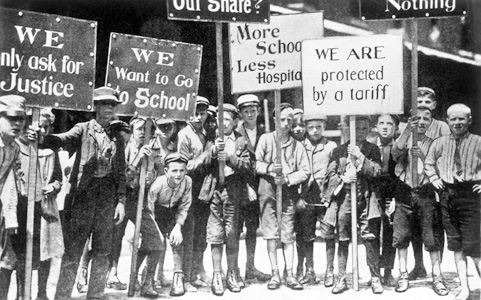Strike, in business and industry, is a stopping of work by a group of employees. All or some of a company’s employees may be involved. A strike is designed to interrupt the normal flow of goods or services that a company produces or handles. The workers use the strike as a bargaining weapon. They hope that a strike or the threat of a strike will persuade the company to agree to their demands for higher wages, improved working conditions, or other benefits.

The term strike also refers to any stoppage of normal operations or activities to protest an action or condition. During the 1950’s and 1960’s, some civil rights workers in the United States staged sit-down strikes. They sat down in public places and refused to move to protest racial injustice. Some prison inmates have gone on hunger strikes and refused to eat until officials considered their grievances. College students have struck for various kinds of changes. But strikes are most closely associated with work stoppages in business and industry. This article chiefly discusses such labor strikes.
Functions of strikes.
A strike is a sign of dissatisfaction among workers in a plant or industry. By striking, workers take action to express a grievance or to enforce a demand. In the 1800’s and early 1900’s, many strikes in the United States resulted from workers’ efforts to get employers to recognize unions as their bargaining agents. But most strikes today involve disputes over wages, hours, and other conditions of employment.
Strikes are an important part of the collective bargaining process between workers and employers. In this process, representatives of both parties meet to establish conditions of employment that will be jointly acceptable. Most collective bargaining agreements are reached—and renegotiated periodically—without strikes.
Strikes occur occasionally in any society that encourages free collective bargaining. No matter how reasonable the two sides may be, disagreements will arise between labor and management. During bargaining, a strike or the threat of a strike increases the cost of being unreasonable. It encourages each side to seriously consider the other’s arguments and demands.
Kinds of strikes.
There are various kinds of strikes. An authorized strike is one agreed upon by union officials or a majority of the union members. A wildcat strike is a strike called by a group of workers without official union support. Most strikes are walkouts, in which the workers leave their jobs. A sit-down strike is a strike in which people stop working but do not leave their place of employment. A sympathy strike is called by one union to support another union that is on strike. A jurisdictional strike may result when two or more rival unions claim the exclusive right to do certain work. A secondary strike occurs when people stop working to try to force their employer to stop doing business with another employer who is involved in a labor dispute.
Generally, nonpublic employees have the right to strike. Similarly, private employers may close their plants in order to keep employees from working. Such action is called a lockout. Almost all collective bargaining agreements prohibit strikes and lockouts during the term of a contract. In the United States, federal laws also prohibit or limit certain kinds of strikes. For example, the Taft-Hartley Act bans jurisdictional strikes, secondary strikes, and sympathy strikes. The Taft-Hartley Act and the Railway Labor Act include provisions to delay strikes that might create a national emergency.
Many states have laws forbidding strikes by employees of the state or local government. But strikes by such public employees as police and teachers became common in the 1960’s and 1970’s. Several states passed laws giving government workers the right to strike.
Strike tactics
in the United States and other industrial countries have been relatively peaceful for many years. But fights, loss of life, and destruction of property were common in the 1800’s and early 1900’s.
Union members usually follow authorized strike-vote procedures, though occasionally a wildcat strike may occur. Many unions have special strike funds to help support the strikers.
When a strike begins, union members usually set up picket lines at entrances to the employer’s place of business. The pickets carry signs telling why they are striking. The purpose of the picket line is to turn away other workers, to discourage customers, and to keep goods from being taken into or out of the plant. Union members often refuse to cross another union’s picket line.
Strike settlements.
Most strikes are settled through negotiations between representatives of labor and management. A neutral third party may help the parties reach a settlement. Third parties participate in both mediation and arbitration. In mediation, the third party tries to promote discussion, to work out compromises, and to find areas of agreement. A mediator has no power to force a settlement. In arbitration, the third party has the power to settle a strike. An arbitrator is given the power of binding arbitration through voluntary agreement of the parties involved or by law. Binding arbitration requires both sides to accept the recommendations of the arbitrator.
